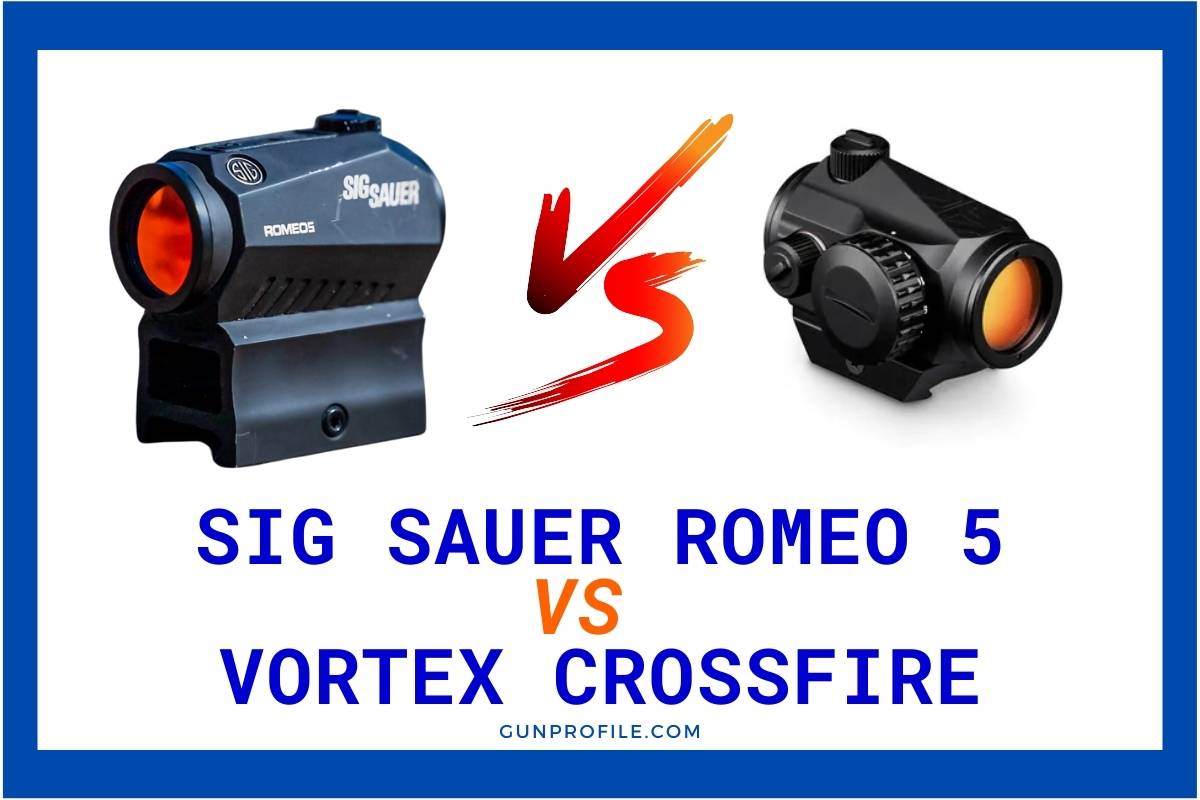Red dot sights have become popular for their quick target acquisition and ease of use. Two well-known options in this category are the Sig Sauer Romeo 5 and the Vortex Crossfire. These compact sights offer similar features but have some key differences that may sway buyers.
The Sig Sauer Romeo 5 stands out with its motion-activated illumination feature, while the Vortex Crossfire is known for its durability and simplicity. Both sights provide reliable performance for shooters, but each has unique strengths that may appeal to different users.
Choosing between these two red dot sights depends on individual needs and preferences. Factors like adjustment precision, battery life, and price all play a role in making the right choice. By comparing these aspects, shooters can determine which sight best fits their specific requirements.
Key Takeaways
- Both sights offer reliable performance with some unique features.
- The Romeo 5’s motion activation may appeal to those prioritizing battery life.
- Precision and durability are key factors to consider when choosing between the two.
Overview of Sig Sauer Romeo 5 and Vortex Crossfire
The Sig Sauer Romeo 5 and Vortex Crossfire are popular red dot sights for firearms. Both offer key features that appeal to shooters looking for reliable optics.
Sig Sauer Romeo 5 Features
The Romeo 5 is known for its MOTAC (Motion Activated Illumination) system. This feature turns the sight on when it detects movement and off when still. It helps save battery life.
The sight has a 2 MOA red dot, which is good for precision aiming. It runs on a CR2032 battery and can last up to 40,000 hours.
The Romeo 5 is waterproof and fog-proof. It comes with low and high mounts for different setups. The controls are simple, with buttons for adjusting brightness.
Vortex Crossfire Features
The Vortex Crossfire stands out for its long battery life of 50,000 hours. It uses the same CR2032 battery as the Romeo 5.
This sight also has a 2 MOA red dot. It offers 11 brightness settings for different lighting conditions. The Crossfire is built tough, with a shockproof aluminum body.
Vortex is known for its excellent warranty. The Crossfire comes with a lifetime warranty that covers any damage or defects. It includes a low mount, with options to buy different heights.
Optical Quality and Performance
The Sig Sauer Romeo 5 and Vortex Crossfire differ in their optical features and performance. Both sights offer clear views and accurate reticles, but they have distinct characteristics that set them apart.
Glass Clarity
The Romeo 5 and Crossfire both provide clear glass for unobstructed viewing. The Romeo 5 has a slightly bluer tint, while the Crossfire lens appears more neutral. This difference is minor and doesn’t impact target acquisition significantly.
Both sights use high-quality glass with anti-reflective coatings. These coatings reduce glare and improve light transmission. Users report minimal distortion around the edges of the glass on both models.
The Romeo 5 may have a slight edge in low-light conditions. Its glass seems to gather light more effectively, giving a brighter image at dusk or dawn.
Reticle Design
The Romeo 5 features a 2 MOA red dot, while the Crossfire offers a 2 MOA dot as well. Both reticles are crisp and easy to see in various lighting conditions.
The Romeo 5 has 8 daylight and 2 night vision brightness settings. The Crossfire provides 11 brightness levels. This gives the Crossfire a slight advantage in fine-tuning dot intensity.
The Romeo 5’s MOTAC (Motion Activated Illumination) system turns the sight on when it detects motion. This feature saves battery life and ensures the sight is ready when needed. The Crossfire lacks this auto-on function.
Both sights offer precise adjustments. The Romeo 5 has 0.5 MOA adjustments, while the Crossfire uses 1 MOA increments. This makes the Romeo 5 slightly more precise for zeroing.
Build Quality and Durability
The Sig Sauer Romeo 5 and Vortex Crossfire differ in their construction and ability to withstand harsh conditions. Both offer solid build quality, but each has unique features that set them apart.
Materials and Construction
The Romeo 5 uses aircraft-grade aluminum for its housing. This material provides strength while keeping the sight lightweight. The Crossfire also uses aluminum, giving it similar durability.
Both sights have a matte black finish to reduce glare. This coating helps protect against scratches and wear.
The Romeo 5 features MOTAC (Motion Activated Illumination). This turns the sight on when it detects movement and off when idle, saving battery life.
The Crossfire has a simpler design without motion activation. It relies on manual controls, which some users prefer for reliability.
Weather Resistance
Both sights are built to handle tough outdoor conditions. The Romeo 5 is IPX-7 rated, meaning it can be submerged in 1 meter of water for 30 minutes.
The Crossfire is also water-resistant, though its exact rating isn’t specified. It can handle rain and moisture without issues.
Fog-proof performance is crucial for clear sighting. Both use nitrogen purging to prevent internal fogging in changing temperatures.
The Romeo 5 and Crossfire are designed to work in extreme temperatures. They can operate in both very cold and very hot environments without losing function.
Mounting Options and Ease of Use
The Sig Sauer Romeo 5 and Vortex Crossfire offer different mounting configurations and control systems. These factors affect compatibility with firearms and user experience.
Compatibility with Firearms
The Romeo 5 comes with two mount options: a low mount and a co-witness mount. The low mount works well for pistols and shotguns. The co-witness mount is ideal for AR-style rifles.
The Vortex Crossfire typically includes a lower 1/3 co-witness mount. This height suits most AR platforms. Both sights use a common mounting system compatible with many aftermarket mounts.
For AR-15 rifles, the standard height mount is generally preferred for proper co-witnessing. The Romeo 5’s low mount may be too low for this purpose on an AR.
Both sights can be used on various firearms beyond AR-style rifles. Their versatile mounting options make them suitable for handguns, shotguns, and other rifle platforms.
User Interface and Controls
The Romeo 5 features Motion Activated Illumination (MOTAC). This system turns the sight on when it detects movement and off when idle. It uses button controls for adjustments.
The Vortex Crossfire has a more traditional manual on/off switch. It uses turret-style adjustments for windage and elevation.
Both sights have multiple brightness settings. The Romeo 5 offers 10 daylight and 2 night vision settings. The Crossfire provides 11 brightness levels.
Battery life differs between the two. The Romeo 5’s MOTAC system helps extend battery life significantly. The Crossfire boasts a long battery life even without an auto-shutoff feature.
Battery Life and Power Source
The Sig Sauer Romeo 5 and Vortex Crossfire use different battery types and offer varying battery life.
The Romeo 5 operates on a CR2032 battery. It boasts an impressive 50,000 hours of battery life on lower brightness settings.
In contrast, the Vortex Crossfire uses a CR2032 battery as well. It provides up to 7,000 hours of battery life with continuous use.
Both sights feature multiple brightness settings. Higher settings consume more power, reducing overall battery life.
The Romeo 5 has a unique MOTAC (Motion Activated Illumination) feature. This technology turns the sight on when it detects motion and off during inactivity, extending battery life.
The Crossfire lacks motion activation but compensates with its simple, reliable design. Its battery compartment is easily accessible for quick changes.
Users should consider their specific needs when choosing between these two models. Those prioritizing extended battery life may prefer the Romeo 5, while others might value the Crossfire’s straightforward operation.
Price Comparison and Value
The Sig Sauer Romeo 5 and Vortex Crossfire are both affordable red dot sights. Their prices are similar, making them popular choices for budget-conscious shooters.
The Romeo 5 typically costs around $125, while the Crossfire is often priced slightly higher. Price fluctuations occur based on retailers and promotions.
Both sights offer good value for their price points. They provide reliable performance and durability at a fraction of the cost of high-end optics.
The Romeo 5 stands out with its motion-activated illumination feature, which can extend battery life. This adds to its overall value proposition.
Vortex’s lifetime warranty gives the Crossfire an edge in long-term value. It provides peace of mind for users who plan to keep their sight for many years.
When considering price and value, buyers should weigh these factors:
- Initial cost
- Battery life
- Warranty coverage
- Additional features
Both sights represent solid investments for shooters seeking quality optics without breaking the bank.
Frequently Asked Questions
The Sig Sauer Romeo 5 and Vortex Crossfire have key differences in features, performance, and user experiences. These red dot sights offer distinct advantages for AR-15 owners looking to enhance their optics.
What are the main differences in specifications between the Sig Sauer Romeo 5 and the Vortex Crossfire?
The Sig Sauer Romeo 5 features MOTAC technology for automatic on/off, while the Vortex Crossfire does not. Both have a 2 MOA red dot, but the Romeo 5 offers 0.5 MOA adjustments compared to the Crossfire’s 1 MOA adjustments.
The Crossfire boasts a longer battery life at 50,000 hours on medium settings. The Romeo 5 has a more compact design and weighs slightly less than the Crossfire.
How do user experiences compare for the Sig Sauer Romeo 5 and the Vortex Crossfire when mounted on an AR-15?
Users often praise the Romeo 5’s shake awake feature for its convenience on AR-15 platforms. The Crossfire receives positive feedback for its simple controls and clear glass.
Some shooters find the Romeo 5’s button operation more intuitive than the Crossfire’s dial system. Both sights are reported to hold zero well on AR-15s during extended use.
What are the battery life and power features of Sig Sauer Romeo 5 in contrast to Vortex Crossfire?
The Sig Sauer Romeo 5 uses MOTAC (Motion Activated Illumination) to extend battery life. This feature turns the sight on when it detects motion and off during inactivity.
The Vortex Crossfire claims a 50,000-hour battery life on medium brightness settings. Both sights use a CR2032 battery, but real-world battery life can vary based on usage and settings.
How does the reticle clarity and brightness of the Sig Sauer Romeo 5 compare to the Vortex Crossfire?
Both sights offer a 2 MOA red dot reticle. The Romeo 5 provides 8 daylight and 2 night-vision compatible brightness settings. The Crossfire has 11 brightness settings.
Users generally report good dot clarity for both sights. Some shooters find the Romeo 5’s dot slightly crisper, while others prefer the Crossfire’s brightness range.
Can you compare the durability and construction quality between the Sig Sauer Romeo 5 and Vortex Crossfire optics?
Both sights are built to withstand harsh conditions. The Romeo 5 and Crossfire feature aircraft-grade aluminum housings and are waterproof.
The Romeo 5 has undergone extensive torture testing, demonstrating impressive durability. The Crossfire is also known for its rugged construction and ability to maintain zero under stress.
What are the warranty services offered for Sig Sauer Romeo 5 and Vortex Crossfire?
Sig Sauer offers a 5-year electronics warranty and unlimited lifetime warranty for the Romeo 5’s housing. Vortex provides their VIP warranty for the Crossfire.
The Vortex warranty is unconditional and transferable, covering all repairs or replacements at no cost to the owner. This comprehensive coverage is a significant selling point for many Crossfire users.

